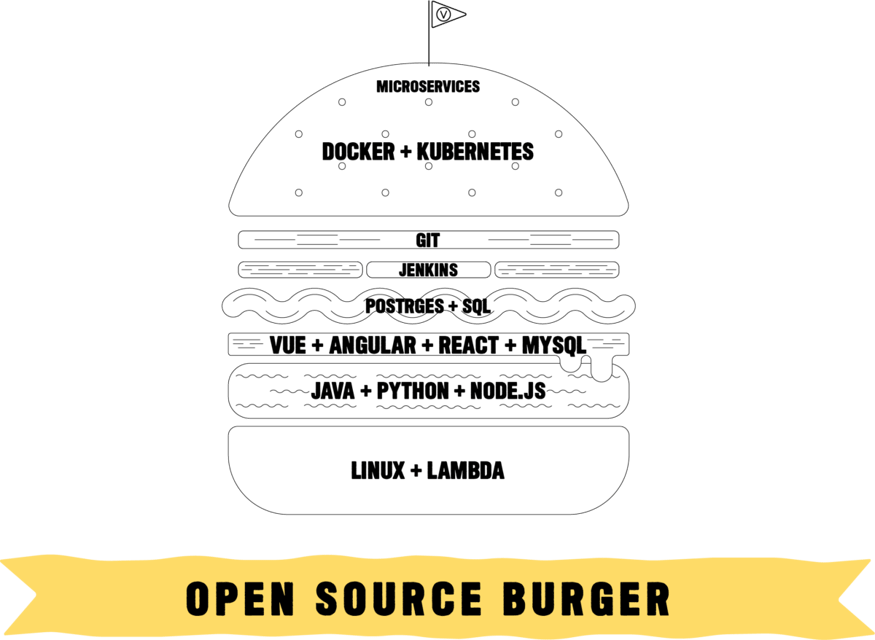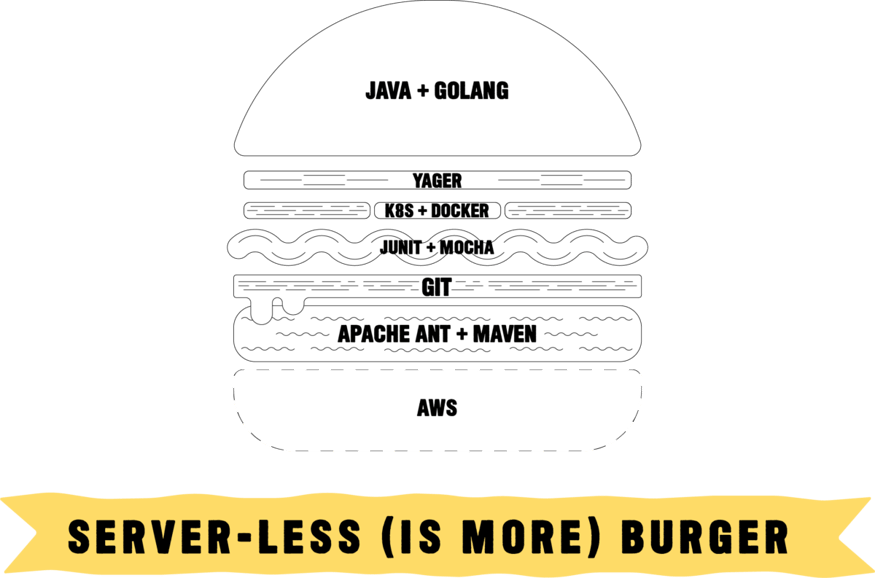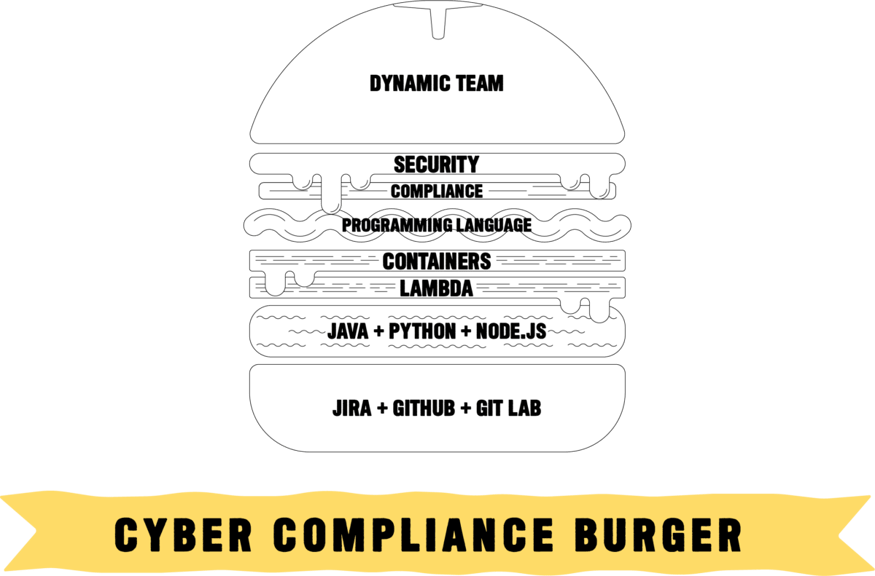Three Simple Work-Day Recipes for the DevSecOps Engineer
6 MIN READ
12/10/2019 | DevSecOps

Let’s get ready to crumble...bacon that is, for our gourmet Software Engineering Burger Bar. We’re going to slice and dice the different stacks and layers of three different variations of that same technique, DevSecOps. Dun, dun, dun. DevSecOps can seem kind of intimidating because it hasn’t even been around for ten years—basically not yet a well-aged cheese—but it’s aging and everything good comes with age, maybe besides saggy buns. Alas, back to le burger. Just like at any one of the burger joints in your town, stacking and using software can be comparable. Gather round, friends, and grab some fries for the ride...
Server-less (is more) Burger:
We’ll start with a server-less burger—waiter not included. This stack is priced by consumption, not capacity. It’s the new classic, the toppings (read: technologies) are streamlined and delicious. When we say serverless, there is still a server it’s just public vs. private. Amazon Web Services, or AWS, is a very commonly used public server. Kind of like a toasted brioche bun. There are competitors, such as Azure or GCP, great options, but sometimes you just want to stick with what you know. So, you’ve got your hands-free top bun as the base. Now, this base needs to be able to withstand the tender juices and complex flavors that are layered above. The meat of the situation is comparable to the back end. Maven and Apache ANT are great examples of tools that are utilized, accessed and played with daily.
In this burger, the backend is really beefed up, pun intended. Cheese is so important; we need to Git this one right—see what I did there? This is where the magic—I mean merge—happens. All changes are tracked through Git, making this the perfect example for the cheesiest layer. Testing the strength of the condiments and toppings above is the lettuce; Junit and Mocha creating a test zone for the experience below. Containing the most flavor are the red onions, K8s and Docker. This is what makes the stack taste like the whole package. Yager soaked tomatoes—enhancing developer productivity—wink, wink. We’ll finish this stack off with our top bun, the coding languages; Java and Golang. Tada! Less truly is more.

Open Source (Health Nut):
Oh, my goodness, so light, so lean. Looking for something a bit more open to interpretation? Perhaps you’re like a contestant on Chopped—slicing and dicing anything and everything that comes your way. But wait, what’s this? A meat substitute for a burger? Yes, at MetroStar we like all stacks #icantbelieveitsnotbeef. This is our Open Source stack—a lean, mean DevOps machine. As Kanye West once said, “harder, better, faster, stronger” and these words apply—don’t tell Kanye, he loves himself enough. Open source is not your basic stack, it takes dedication and understanding.
Base bun is our infrastructure. We’ve got Linux and Lambda doing their thing, supporting the stack. There is also the AWS cloud element. Sliding right on top of that is our #icantbelieveitsnotbeef patty. This is where Java, Python and Node.js lives. They hang out and chat with each other in the backend. Their different complexities really make it seem like you’re not eating an openly sourced burger. Cheese in this layer marks the separation between frontend and backend. It secures the backend into place. Vue, Angular and React are some tools that could be wonderful cheese replacements.
The lettuce here is represented as Postgres and SQL, a managing database and a corresponding programming language, allowing our backend and database layers to have conversations—maybe about their flavors, or maybe about their horoscopes. Started from the bottom, now we’re here—at the onion portion of our stack. Jenkins is layered near the top of our burger because it’s checking to make sure all aforementioned layers are deployable for continuous delivery. Git is underneath the cap that is our top bun. This tomato layer tracks all the changes of the stack, helping engineers Git ‘er done.
Our container (read: bun) is Docker and Kubernetes helps manage. Now this bun has sesame seeds because who doesn’t like being a little extra sometimes—anyone? Microservices helps with the structured style of our stack. Sesame seeds are relatively micro, and they help add that little bit of extra style to make this stack stand out from the REST.
C.C.B. (Cyber Compliance Burger):
In the wise words of Gandalf, the Grey, “Keep it secret, keep it safe,” and that’s the purpose of this stack. It contains all the necessary layers, while simultaneously keeping it secure. It’s got that secret sauce near the top that secures all other flavors in their place. Our bun for this stack doesn’t start with AWS, it layers Jira, Git Hub and Git Lab. It’s an agile process that allows for your own bomb stack attack. Now, the meat is where DevOps comes to life—yum. Some spices (read: tools and a cloud provider) in this mix are Terraform, Tensor Flow, Azure and Splunk, to name a few.
All these flavors getting to know each other simultaneously and constantly represents the DevOps lifecycle. Lambda is our cheese selection, sourced from goats' milk—if we’re getting technical here—for a smooth, cream effect. This adds to the structure of the stack itself. Containers can also be represented by cheese because the cheese melted over the ingredients below, acts as a container for goodness.
The lettuce is where the programming language comes in. It’s the Software Engineering portion of the C.C.B. Before we can reach the top, the ingredients need to be talking to one another, or we can’t close the deal with the top bun. All our handcrafted, hand-selected burger accoutrement needs to be safe.
We can’t have this stuff leaking out the sides, nobody likes a leaky burger. Cyber compliance is our tomatoes and the special sauce is the security. Keeping everything below safe, secure and ever so juicy is the top bun—a dynamic team of engineers. My precious, my C.C.B.
Here at MetroStar we are committed to putting our employees first in order to create new opportunities and advancement across mission critical programs that touch millions of citizens and protect our great nation. Although the technologies we tackle are always evolving, the heart and soul of our organization is a diverse community of experts across technology and the humanities who believe in the power of technology to dramatically transform the way citizens engage with the government.
Hungry after all this burger talk?
Click apply to find out how you can start stackin' with our crew!

Written By:
MetroStar Systems
Former Contributor
you might like these too
Accelerating Oracle Environments with Open Source
DevSecOps | AI/ML | Innovation Lab
Why We Built a Free and Open Source Cybersecurity Solution
DevSecOps | Cyber
MetroStar Integrates Salesforce for Next-Gen Manpower Management
Cloud | DevSecOps | AI/ML | Data Analytics | Our Work
want to stay in the loop?
Never miss a thing by signing up for our newsletter. We periodically send out important news, blogs, and other announcements. Don’t worry, we promise not to spam you.



